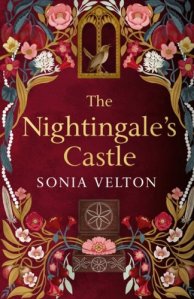 Countess Erzsébet Báthory (often anglicised to Elizabeth Bathory) has found her way into vampire folklore as one of the possible inspirations behind Bram Stoker’s Dracula. Known as the Blood Countess for her habit of bathing in the blood of her victims to retain her youthful appearance, she and her servants were accused of murdering hundreds of Hungarian peasant girls, making her one of the most notorious serial killers in history. In her new novel The Nightingale’s Castle, Sonia Velton reimagines Erzsébet’s story and looks at the woman behind the legends.
Countess Erzsébet Báthory (often anglicised to Elizabeth Bathory) has found her way into vampire folklore as one of the possible inspirations behind Bram Stoker’s Dracula. Known as the Blood Countess for her habit of bathing in the blood of her victims to retain her youthful appearance, she and her servants were accused of murdering hundreds of Hungarian peasant girls, making her one of the most notorious serial killers in history. In her new novel The Nightingale’s Castle, Sonia Velton reimagines Erzsébet’s story and looks at the woman behind the legends.
The novel opens in Hungary in 1610 and introduces us to fifteen-year-old Boróka, who has been raised by an adoptive father in the foothills of the Carpathian Mountains. When members of the Countess’s household arrive at Boróka’s cottage looking for girls to come and work at Čachtice Castle, she is initially reluctant to go, but her father persuades her that it would be dangerous not to accept. And so Boróka soon finds herself in a carriage heading up the hill towards the castle and a new way of life.
Within the walls of Čachtice Castle, there are other girls like Boróka working as seamstresses, cooks and kitchen maids under the watchful eyes of the Countess’s personal staff, whom Boróka finds to be excessively cruel and vindictive. She struggles to settle in, but when she and Erzsébet Báthory eventually cross paths Boróka becomes a favourite of the Countess’s, which gives her some degree of protection. Then come the accusations of murder and torture and Boróka must try to make sense of what has really been going on in the castle and whether or not the allegations could be true.
I had heard of Erzsébet Báthory before starting this novel, but knew very little about her, so it was good to have the opportunity to learn more. Of course, this is fiction and obviously Sonia Velton will have had to use her imagination to flesh out the plot and characters, but I could see from her very detailed author’s note at the end of the book that she has carried out a lot of research and tried to put some theories together that fit the historical facts. This version of Báthory’s character is more sympathetic than the way she is usually portrayed and the servants who are arrested along with her, particularly Dorottya Szentes and Ilona Jó, are the real villains here. I would probably need to read some non-fiction on the subject before I could say whether I agreed with this or not.
Despite Erzsébet Báthory’s association with vampire legends, there are no vampires in Velton’s novel and for the most part this is a straightforward work of historical fiction. However, there’s a subplot involving a magical rosewood box which I thought seemed out of place; I felt that the book either needed more fantasy elements or none at all. Apart from that, I found The Nightingale’s Castle an interesting read and I’m sure other people will appreciate that little touch of magical realism more than I did.
This is Sonia Velton’s third novel. I haven’t read The Image of Her, which seems to be a contemporary thriller set in Dubai, but I enjoyed her first book, Blackberry and Wild Rose, about a community of Huguenot silk weavers in 18th century London. She does pick interesting subjects and settings for her novels, so I’ll look forward to seeing what she writes next.
Thanks to Abacus for providing a copy of this book for review via NetGalley.
Book 23/50 for the Historical Fiction Reading Challenge 2024

Blackberry and Wild Rose didn’t work for me, so I’ll probably avoid this, but it’s interesting to have an author pick up the myth of Báthory. I tend to agree with you that a work of this nature needs to either lean into a fantastical/supernatural explanation, or have no fantasy components at all.
I think this book might have actually worked better as a fantasy/supernatural novel. Only including one fantasy component just seemed odd.
I say this all the time: if an author wants to make it genre, commit!
Interesting subject….. [muses]
Definitely!
Bathory sure has spawned a lot of myths and stories. Makes you wonder what the truth about her actually is. Although she can’t have been all that nice if she bathed in the blood of murdered young women. This sounds like an interesting take on her life.
Yes, it was an interesting take and I would like to read more about Elizabeth Bathory now. I doubt the stories about her bathing in blood are true, but who knows!
I’d not heard of Erzsébet Báthory before now but having just googled her it sounds like the evidence for what she was alleged to have done is, by modern standards, strikingly absent. I can see why the rumours surrounding her propensities would be good grist for a novel!
I’m sure the truth about Báthory would be much more mundane than the legends suggest, but she’s certainly a great subject for a novel!